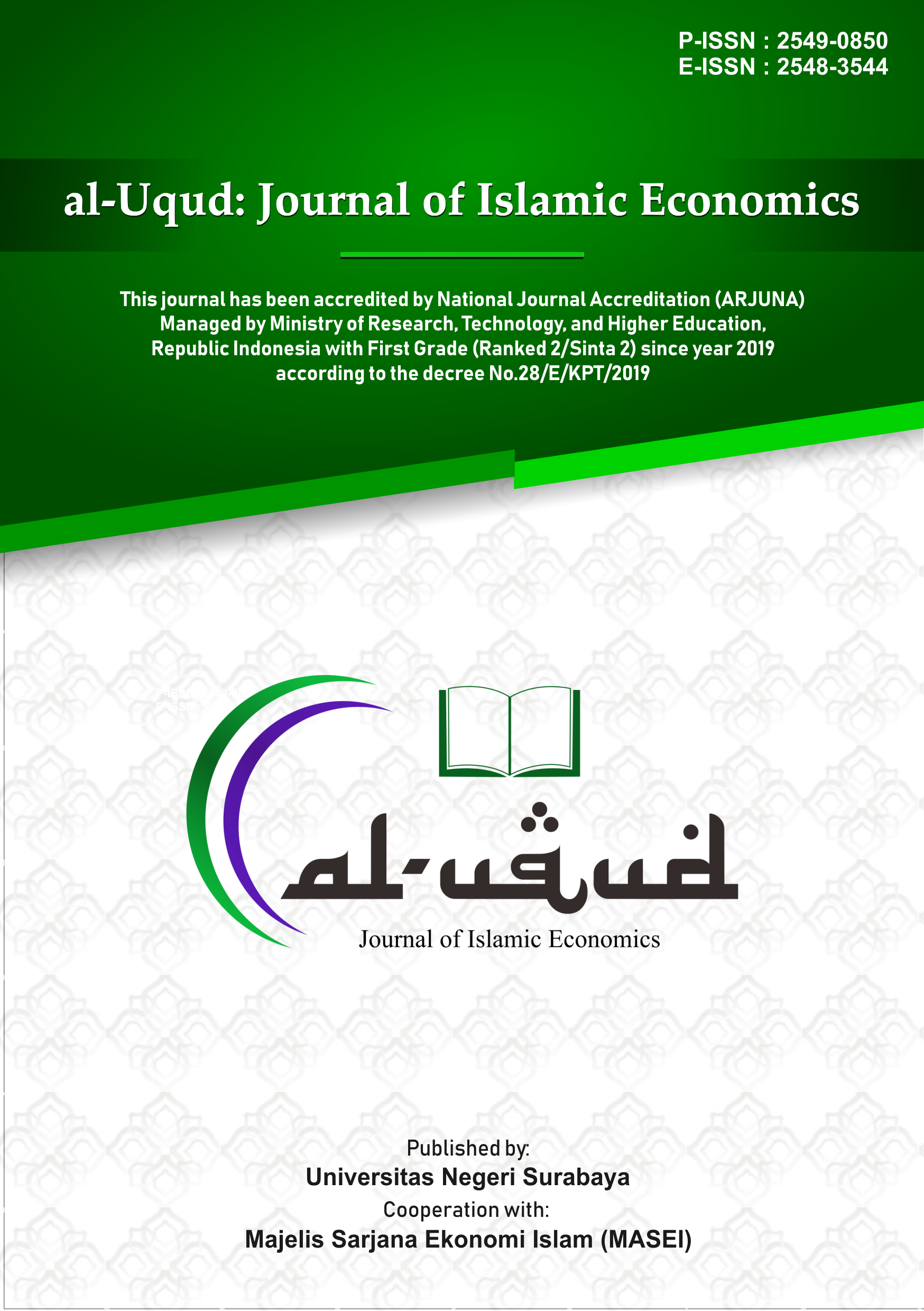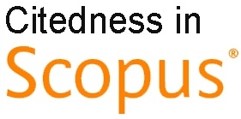The Influence of Muslim Batik Entrepreneurs' Financial Literacy of The Banking Sector on Productivity
DOI:
https://doi.org/10.26740/al-uqud.v5n1.p60-75Keywords:
Financial literacy on banking sector, Capital adequacy, Banking accessAbstract
The batik business in the Islamic community of the North coast of East Java is categorized as a micro and small business. One of the main problems of the business is capital adequacy. Capital adequacy is one instrument to run and increase productivity. Although the government has provided soft capital loans through banking instruments and rural development program, not all micro and small businesses are willing and able to access it. It is heavily relied on the entrepreneurs' financial literacy on banking sector and their willingness to use banking access. The survey results show that there are variations of the financial literacy level of batik entrepreneurs on banking sector. Batik entrepreneur who have high financial literacy were motivated to access the bank financiang service and improve its productivity.Education and location play a significant role to financial literacy on banking sector.
References
Anwar, M. K., & Febrianto, N. F. (2020). Revisiting Islamic Economics of Nusantara: Conceptual and Legal Perspectives. Al-Uqud: Journal of Islamic Economics, 4(1), 117. https://doi.org/10.26740/al-uqud.v4n1.p1-17
Arthur, C. (2012). Financial Literacy Education. Neoliberalism, the Consumer and the Citizen (1st ed.; M. A. Peters, ed.). Rotterdam: Sense Publishers.
Balling, M., Bernet, B., & Gnan, E. (2009). Financing SMEs in Europe-Some Stylized Facts. In M. Balling, B. Bernet, & E. Gnan (Eds.), Financing SMEs in Europ (1st ed.). Vienna: SUERF.
Bannier, C. E., & Schwarz, M. (2018). Gender- and education-related effects of financial literacy and confidence on financial wealth. Journal of Economic Psychology, 67, 6686. https://doi.org/10.1016/j.joep.2018.05.005
Behrman, J. R., Mitchell, O. S., Soo, C. K., & Bravo, D. (2012). The Effects of Financial Education and Financial Literacy. How Financial Literacy Affects Household Wealth Accumulation. The American Economic Review, 102(3), 16. Retrieved from http://www.jstor.org/stable/23245546
Bhatia, N., & Chatterjee, A. (2010). Financial Inclusion in the Slums of Mumbai. Economic & Political Weekly, 45(42), 2326.
BPS Kabupaten Bojonegoro. (2019). Kabupaten Bojonegoro dalam Angka 2019 (S. I. P. dan D. Statistik, ed.). BPS Kabupaten Bojonegoro.
BPS Kabupaten Tuban. (2019). Kabupaten Tuban Dalam Angka 2019. Tuban: BPS Kab. Tuban.
Brown, M., Henchoz, C., & Spycher, T. (2018). Culture and financial literacy: Evidence from a within-country language border. Journal of Economic Behavior and Organization, 150, 6285. https://doi.org/10.1016/j.jebo.2018.03.011
Bush, S. B., McGatha, M. B., & Bay-Williams, J. M. (2012). Invest in Financial Literacy. Mathematics Teaching in the Middle School, 17(6), 358365.
Castle, L. (1982). Tingkah laku agama, politik dan ekonomi diJawa: industri rokok kudus. Jakarta: Sinar Harapan.
Compen, B., De Witte, K., & Schelfhout, W. (2019). The role of teacher professional development in financial literacy education: A systematic literature review. Educational Research Review, 26, 1631. https://doi.org/10.1016/j.edurev.2018.12.001
Crain, S. J. (2013). Curriculum Are Universities Improving Student Financial Literacy¯? A Study of General Education Curriculum. Journal of Financial Education, 39(1), 118. Retrieved from http://www.jstor.org/stable/41948694
Creswell, J. W. (2009). Research Design. Qualitative, Quantitative and Mixed Methods Approaches (3rd ed.; J. W. Creswell, ed.). Los Angeles: Sage Publication,Inc.
Cude, B. J. (2010). Financial Literacy 501. He Journal of Consumer, 44(2), 271275. Retrieved from http://www.jstor.org/stable/41494444
Damuri, Y. R., Atje, R., Alexandra, L. A., & Soedjito, A. (2014). A Maritime Silk Road and Indonesia's Perspective of Maritime State. The Embassy of the People's Republic of China in the Republic of Indonesia, p. 41. Jakarta: CSIS.
Douissa, I. Ben. (2019). Factors affecting College students' multidimensional financial literacy in the Middle East. International Review of Economics Education, 100173. https://doi.org/10.1016/j.iree.2019.100173
Durrani, M., & Boocock, G. (2006). Venture Capital , Islamic Finance and SMEs. Valuation, Structuring and Monitoring Practices in India (1st ed.). Hampshire: Palgrave Macmillan.
Elliot, I. M., Haake, A., Harper, D., Hope, J., Majlis, B. K., Smend, R., ¦ Wronska-Friend, M. (2016). Batik. Traditional Textiles of Indonesia. From the Rudolf Smend & Donald Harper Collections (1st ed.). Tokyo: Tuttle Publishing.
Fahrezi, A. A. (2019). Faktor-faktor yang mempengaruhi pedagang muslim melakukan kredit pada bank plecit (Studi Kasus Pasar Lebaksiu Kabupaten Tegal. Universitas Muhammadiyah Surakarta.
Fanta, A. B., & Mutsonziwa, K. (2016). Gender and financial inclusion. (1). Retrieved from http://www.finmark.org.za/wp-content/uploads/2016/08/gender-and-financial-inclusion.pdf
Gangi, F., Meles, A., Monferrà , S., & Mustilli, M. (2018). Does corporate social responsibility help the survivorship of SMEs and large firms? Global Finance Journal, (2017). https://doi.org/10.1016/j.gfj.2018.01.006
Geertz, C. (1963). Peddlers and Princes: Social Development and Economic Change in Two Indonesian Towns. 162. https://doi.org/10.1017/CBO9781107415324.004
Harness, D., Ranaweera, C., Karjaluoto, H., & Jayawardhena, C. (2018). The role of negative and positive forms of power in supporting CSR alignment and commitment between large firms and SMEs. Industrial Marketing Management, (February), 01. https://doi.org/10.1016/j.indmarman.2018.03.006
Henchoz, C. (2016). Sociological Perspective on Financial Literacy. A Critical Examination of Three Assumptions Underlying Financial Literacy Programme. In C. Aprea, E. Wuttke, K. Breuer, B. Reimel-Fuhrmann, P. Davies, & J. S. Lopus (Eds.), International Handbook of Financial Literacy (1st ed., pp. 97112). https://doi.org/10.1007/978-981-10-0360-8
Hsiao, Y. J., & Tsai, W. C. (2018). Financial literacy and participation in the derivatives markets. Journal of Banking and Finance, 88, 1529. https://doi.org/10.1016/j.jbankfin.2017.11.006
Huston, S. J. (2010). Measuring Financial Literacy. The Journal of Consumer Affairs, 44(2), 296316. Retrieved from http://www.jstor.org/stable/23859793
IFC World Bank Group, & NORC at the University of Chicago. (2010). Serving the Needs of Indonesian SMEs. Main Findings. Retrieved from World Bank Group website: http://documents.worldbank.org/curated/en/556861495102658074/Serving-the-financial-needs-of-Indonesian-SMEs-main-findings
Kersten, C. (2015). Islam In Indonesia. The Contest for Society, Ideas and Values. Oxford: Oxford University Press, Inc.
Kersten, C. (2017). A History of Islam in Indonesia. Unity in Diversity (1st ed.). Edinburgh University Press.
Kiliyanni, A. L., & Sivaraman, S. (2016). The perception-reality gap in financial literacy: Evidence from the most literate state in India. International Review of Economics Education, 23, 4764. https://doi.org/10.1016/j.iree.2016.07.001
Kurniawanto, R. T. (2014). Pengaruh pinjaman modal kegiatan simpan pinjam kelompok perempuan PNPM Mandiri Perdesaan serta sikap wirausaha terhadap perkembangan usaha dan peningkatan pendapatan masyarakat Kec. Ambal, Kabupaten Kebumen (Universitas Negeri Yogyakarta). https://doi.org/10.4324/9781315853178
Martinez, V. (2016). Financial Literacy Among our Students: Assessing and Improving Their Knowledge. Journal of Financial Education, 42(3), 291303.
Mendikbud RI. (2016). Peraturan Menteri Pendidikan dan Kebudayaan No 21 tahun 2016 tentang Standar Isi Pendidikan Dasar dan Menengah. Jakarta.
Menkhoff, T., & Gerke, S. (2012). Asia's Transformation and The Role of The Ethnic Chinese. In T. Menkhoff & S. Gerke (Eds.), Chinese Entrepreneurship and Asian Business Networks (1st ed., pp. 319). https://doi.org/10.4324/9780203060308
Moreno-Herrero, D., Salas-Velasco, M., & Sánchez-Campillo, J. (2018). Factors that influence the level of financial literacy among young people: The role of parental engagement and students' experiences with money matters. Children and Youth Services Review, 95(October), 334351. https://doi.org/10.1016/j.childyouth.2018.10.042
Nuryakin, C., Aisha, L., & Massie, N. W. G. (2019). Financial Technology in Indonesia: A Fragmented Instrument for Financial Inclusion¯? (No. 36). Jakarta.
Peet, R., & Hartwick, E. (2009). Theories of development. contentions, arguments, Alternatives. New York: the Guilford Press.
Rae, I., & Witzel, M. (2008). The Overseas Chinese of South East Asia. History, Culture, Business. In 1 (Ed.), Pacific Affairs (Vol. 34). https://doi.org/10.1057/9780230593121
Rahajuni, D. (2015). Evaluasi Simpan Pinjam PNPM Mandiri Perdesaan untuk Mengurasi Kemiskinan. Studi Kasus di Kabupaten Banyumas (pp. 920930). pp. 920930. Retrieved from http://jp.feb.unsoed.ac.id/index.php/sca-1/article/viewFile/729/762
Remund, D. L. (2010). Financial Literacy Explicated: The Case for a Clearer Definition in an Increasingly Complex Economy. The Journal of Consumer Affairs, 44(2), 276295. Retrieved from http://www.jstor.org/stable/23859792
Ricklefs, M. C. (2008). A History of Modern Indonesia since c. 1200 (4th ed.; M. C. Ricklefs, Ed.). Hampshire: Palgrave Macmillan.
Rodrigues, L. F., Oliveira, A., Rodrigues, H., & Costa, C. J. (2019). Assessing consumer literacy on financial complex products. Journal of Behavioral and Experimental Finance, 22, 93104. https://doi.org/10.1016/j.jbef.2019.02.005
Rohmah, T. H. (2017). Praktek Bank Plecit di Pasar Tradsional Kecamatan Patikraja Kabupaten Banyumas dalam Perspektif Hukum Islam. Institut Agama Islam Negeri Purwokerto, Purwokerto.
Rosfadhila, M., Toyamah, N., Sulaksono, B., Devina, S., Sodo, R. J., & Syukri, M. (2011). Kajian Cepat Pelaksanaan Program Bantuan Langsung Tunai (BLT) 2008 dan Evaluasi Penerima Program BLT 2005 di Indonesia.
Rupeika-Apoga, R. (2014). Financing in SMEs: Case of the Baltic States. Procedia - Social and Behavioral Sciences, 150, 116125. https://doi.org/10.1016/j.sbspro.2014.09.013
Sarjito. (2018). Fintech and Consumer Protection in Indonesia. Makassar: 3 Annual Islamic Finance Conference.
Seagrave, S. (2006). Lords of the Rim. Sepang Terjang Bisnis Para Taipan (1st ed.; H. Basyaib, Ed.). Jakarta: Pustaka Alvabet.
Sen, S., & Cowley, J. (2013). The Relevance of Stakeholder Theory and Social Capital Theory in the Context of CSR in SMEs¯: An Australian Perspective Australian Bureau of Statistics. 413427. https://doi.org/10.1007/s10551-012-1598-6
Sharma, A., & Johri, A. (2014). Learning and empowerment: Designing a financial literacy tool to teach long-term investing to illiterate women in rural India. Learning, Culture, and Social Interaction, 3(1), 2133. https://doi.org/10.1016/j.lcsi.2013.10.003
van der Kroef, J. M. (1954). Entrepreneur and Middle Class in Indonesia. Economic Development and Cultural Change, 2(4), 297325. Retrieved from http://www.jstor.org/stable/1151629
van der Kroef, J. M. (1960). The Indonesian Entrepreneur: Images, Potentialities and Problems. Am. J. Econ. Sociol., 19(4), 413425. Retrieved from http://www.jstor.org/stable/3484622
Weidlich, W., & Haag, G. (2012). Concepts and Models of a Quantitative Sociology: The Dynamics of Interacting Populations. Retrieved from https://books.google.com.hk/books?id=dijqCAAAQBAJ
Yunus, M. (2007). Creating World Without Poverty. Social Business and the Future Capitalism. In K. Weber (Ed.), Public Affairs Book (1st ed.). https://doi.org/10.1080/15575330.2014.890406
Zou, J., & Deng, X. (2019). Financial literacy, housing value and household financial market participation: Evidence from urban China. China Economic Review, 55(March), 5266. https://doi.org/10.1016/j.chieco.2019.03.008
Downloads
Additional Files
Published
How to Cite
Issue
Section
License
CC BY 4.0 Abstract views: 497
,
Abstract views: 497
, PDF Downloads: 569
,
PDF Downloads: 569
, PDF Downloads: 0
PDF Downloads: 0








